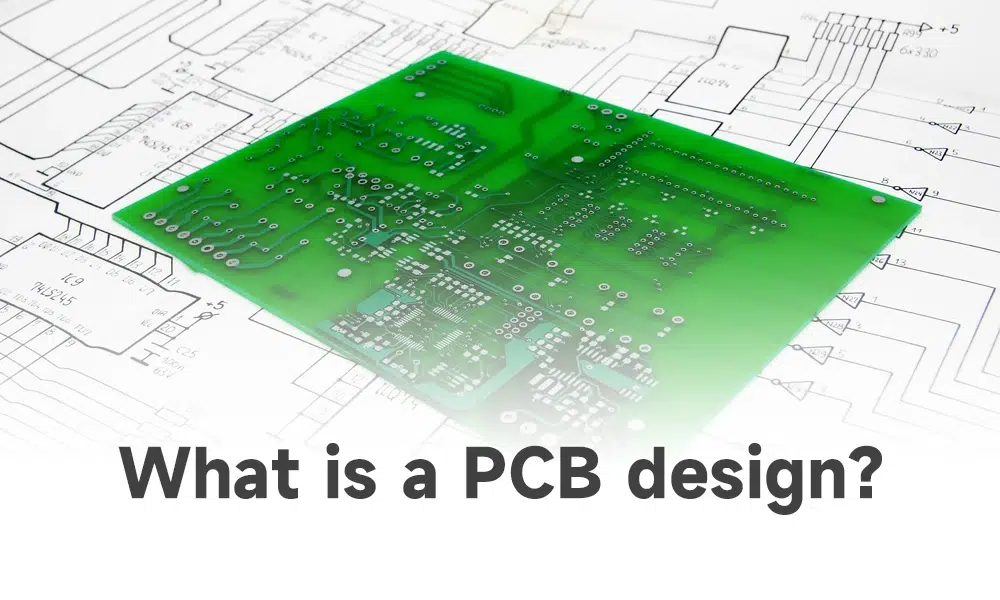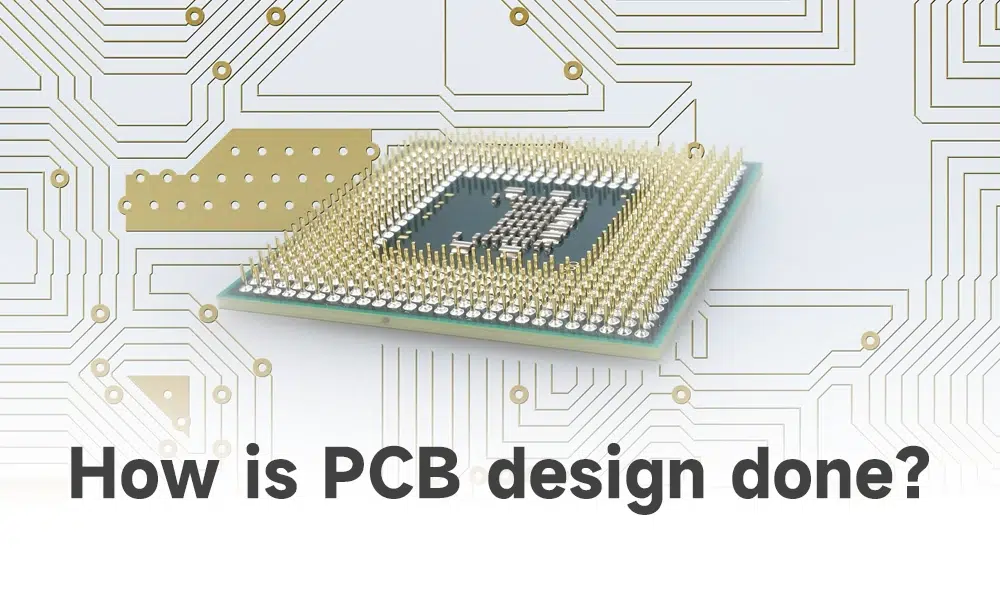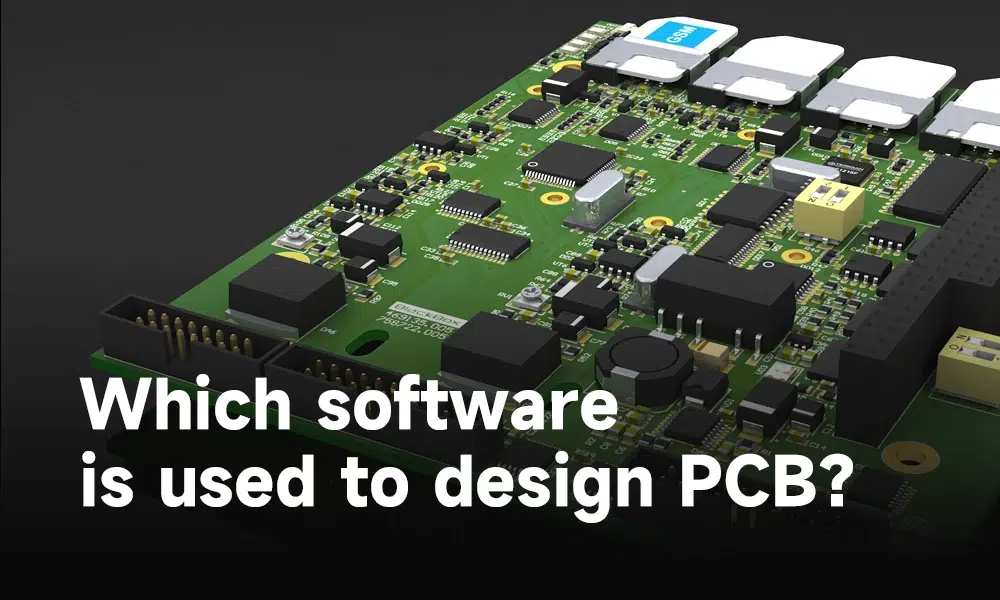PCB design, a crucial facet within electronics engineering, engages in the artful strategy, configuration, and linkage of electronic constituents on a tangible board, functioning as the bedrock of myriad electronic contraptions. This operation guarantees not only operational circuits but also economic, dependable, and effective ones.
In this all-encompassing expedition, we shall plunge into the complexities of PCB design, its significance, the measures involved, and the traits embodying a model PCB design. Moreover, we shall address the regulations, instruments, and amenities underpinning this field, proffering a holistic perspective of this vital dimension in present-day electronics engineering.
What is a PCB design?
A plan, namely the Printed Circuit Board (PCB) design, elaborately specifies the arrangement and interconnection of electronic elements, including resistors, capacitors, integrated circuits, and connectors. These are situated on a tangible, non-conductive substrate, usually constructed from materials such as fiberglass or epoxy. The design encompasses the disposition of components, the establishment of electrical pathways linking them, and the location of vias and other requisite elements essential for the correct operation of an electronic circuit.
PCB designs function as the architectural template for the fabrication of printed circuit boards. Their role lies in ensuring accurate and efficient electrical interconnections, consequently mitigating the potential for errors during the production phase. PCB design can exhibit various degrees of intricacy, ranging from uncomplicated single-layer boards, employed in rudimentary electronic applications, to intricate multi-layer PCB, utilized in cutting-edge electronic gadgets such as smartphones and computers.

Why is circuit design important?
The significance of circuit design cannot be overstated for several compelling rationales:
1.Functionality: A paramount concern lies in the precise and dependable execution of a designated function by electronic apparatus. Whether it be a rudimentary LED oscillator or a multifaceted computing processor, the circuit’s performance must align with expectations to confer utility upon the device.
2.Dependability: A meticulously crafted circuit curtails the probability of component mishaps, electrical short circuits, or other predicaments that might trigger system incapacitation or operational malfunctions. This holds particular gravity in applications of paramount safety, such as medical instruments and automotive systems.
3.Efficacy: The potential to substantially influence energy consumption and operational efficiency lies within circuit design’s purview. Circuits thoughtfully optimized can curtail energy wastage, elongate battery lifespan, and diminish operational expenses.
4.Cost-Effectiveness: Circuit design efficiency can precipitate financial economies concerning component selection, production, and assembly. For example, a reduction in component count or board strata can translate into diminished production costs.
5.Dimensions and Configuration: Circuit design bears a pivotal role in determining the physical dimensions and geometric arrangement of a device. Compact, systematically structured circuits assume pivotal importance in portable and spatially confined applications.
6.Signal Preservation: Painstaking circuit design is requisitioned to uphold signal fidelity, noise minimization, and the preclusion of signal interference in the realm of high-frequency and analog circuits. This assumes vital significance in arenas like telecommunications and data transmission.
7.Expandability and Versatility: An intelligently contrived circuit often eases scalability and adaptability for forthcoming iterations of a product. This versatility can truncate the temporal and financial costs associated with product updates.
8.Innovation: Innovative circuit design possesses the potential to introduce novel functionalities and capabilities in electronic contrivances. Ingenious circuitry can furnish a competitive edge in the market sphere.

How is PCB design done?
PCB design encompasses a series of sequential procedures:
• Employ PCB design software to construct a diagram representing the circuit.
• Incorporate elements and establish their connections.
• Label elements with part numbers and values.
• Opt for suitable elements guided by the schematic.
• Allocate physical representations (footprints) for each element.
• Transfer the netlist from the schematic into the PCB layout workspace.
• Position elements on the PCB surface, while considering facets like signal fidelity, thermal regulation, and manufacturability.
• Outline the board and pinpoint mounting hole locations.
• Forge conductive paths (copper traces) to interlink elements as per the schematic.
• Observe design regulations to sustain proper clearances, circumvent shorts, and preserve signal integrity.
• Employ diverse PCB layers for tracing, as necessitated, and append vias to interconnect traces amid strata.
• Execute a Design Rule Assessment (DRA) to pinpoint and rectify rule infringements.
• Administer an Electrical Rule Examination (ERE) to corroborate electrical associations correspond to the schematic.
• Leverage simulation and analysis tools for scrutinizing signal fidelity, thermal aspects, and impedance control.
• Generate Gerber files, housing manufacturing details such as copper pathways, silkscreen, solder mask, and borehole locales.
• Compile a Bill of Materials (BOM) itemizing elements and quantities.
• Fabricate a prototype PCB for validating the design.
• Undertake practical evaluations to confirm adherence to design specifications.
• Refine the design if requisite, founded on test results.
• Establish comprehensive design records encompassing diagrams, layout data, Gerber files, BOM, and assembly directives.
• Dispatch Gerber files and the BOM to a PCB producer for large-scale output.
• During manufacturing, enforce quality control examinations to affirm PCB compliance with stipulations.
• Fuse elements onto the PCB, abiding by the assembly directives.
• Execute conclusive functional evaluations on the assembled PCBs.
• Deploy the PCBs within the intended electronic devices or systems.
What is PCB design vs schematic design?
PCB design:
Within the realm of PCB design, the focus lies on the tangible configuration of electronic constituents and the interconnection pathways etched onto a printed circuit board. This phase prioritizes meticulous component arrangement, the intricacies of trace routing, and considerations encompassing manufacturability and operational efficacy. PCB design constitutes the pivotal juncture where the conceptual schematic metamorphoses into a discernible board layout.
Schematic Design:
The initial stage of electronic circuit creation is the schematic design. It entails the crafting of a visual representation (schematic diagram) delineating the electrical interconnections and logical structure of a circuit. Schematic design does not delve into the physical alignment of components on a board. Instead, it grapples with the functional and logical facets of the circuit. The schematic assumes the role of a blueprint governing PCB design, dictating the intricacies of component interrelationships.
Which software is used to design PCB?

Multiple software applications find application in the realm of PCB design. Below, we present a concise introduction to a selection of well-regarded options:
1.Eagle: This PCB design tool, characterized by its user-friendly nature and approachable pricing, proves apt for novices in the field.
2.KiCad: An open-source suite devoted to PCB design, it boasts a diverse array of functions, rendering it a fitting choice for both hobbyists and seasoned experts.
3.Altium Designer: This software, classified as top-tier and tailored for professionals, unfolds an array of advanced capabilities primed for intricate PCB designs.
4.Cadence Allegro: An all-encompassing platform dedicated to PCB design, it particularly excels in accommodating multifaceted and high-performance electronic configurations.
5.Autodesk Fusion 360: Merging the realms of PCB design, 3D modeling, and mechanical design, this tool proves valuable for holistic product development integration.
6.OrCAD: This suite delivers an array of resources encompassing schematic representation, PCB arrangement, and simulation, suitable for assorted design prerequisites.
7.PADS: A Siemens EDA creation (previously under the aegis of Mentor Graphics), this PCB design instrument garners renown for its adeptness in managing high-density interconnect configurations.
8.DipTrace: A PCB design software lauded for its user-friendly disposition, it offers diverse tiers catering to the spectrum from novice to expert.
9.EasyEDA: A web-based PCB design utility, it incorporates a collaborative environment alongside a streamlined interface, facilitating cooperative endeavors.
10.Autodesk Eagle (formerly EagleCAD): Dedicating itself to schematic capture and PCB layout, this tool foregrounds simplicity and accessibility as its primary ethos.
What is the ISO standard for PCB design?
While there lacks a dedicated ISO (International Organization for Standardization) specification exclusively tailored for PCB design, this domain frequently operates beneath the umbrella of diverse ISO standards that pertain to facets encompassing quality administration, documentation, and manufacturing methodologies.
ISO 9001:2015 stands as a widely acknowledged benchmark concerning quality control frameworks, a mantle readily adaptable to the PCB design arena, especially when concerning the assurance of excellence, uniformity, and the establishment of a traceable trajectory in design protocols.
Moreover, depending upon the sector and the particulars of the PCB design undertaking, one may encounter standards such as ISO 13485 for PCBs linked to medical contrivances, or ISO 26262 in the context of automotive applications. The specific standard invoked aligns with the industry in question and the project’s distinctive requisites governing PCB design.
What are the factors to consider in designing printed circuit board?
In the realm of PCB design, numerous foundational principles and elements necessitate contemplation:
● Arrangement of Components: Streamline the positioning of components to facilitate efficient routing while addressing concerns of signal fidelity and thermal regulation.
● Path for Traces: Diminish signal disruption, the risk of crosstalk, and mismatches in impedance during trace configuration.
● Grounding Strategies: Enforce a robust ground plane and faithfully adhere to sound grounding methodologies.
● Dispensing Power: Execute the judicious distribution of power to components, mindful of voltage drops and current prerequisites.
● Safeguarding Signal Fidelity: Commit heed to impedance maintenance, proper termination, and congruence in signal path lengths.
● Managing Thermal Conditions: Assure ample spacing for heat dissipation concerning components and contemplate the placement of heat-vulnerable elements.
● Embrace Manufacturability in Design (Design for Manufacturability – DFM): Integrate design strategies mindful of manufacturing processes, aimed at cost reduction and enhanced dependability.
● Deliberation on EMC/EMI Factors: Institute measures for assuaging electromagnetic interference (EMI) and guarantee compliance with electromagnetic compatibility (EMC) mandates.
● Streamlining and Modularization: Aspire to retain a design marked by simplicity, leaning on modular constituents whenever fitting.
What are the characteristics of a good PCB design?
A commendable PCB design typically displays the subsequent attributes:
1.Operational Excellence: The circuit ensures dependable execution of its designated function.
2.Dependable Performance: It diminishes the probability of component mishaps, electrical shorts, or inaccuracies.
3.Optimal Utilization of Resources: It effectively manages power utilization while curtailing heat production.
4.Dimensions and Configuration: The structure is compact and harmonizes with the physical restrictions of the device.
5.Preservation of Signal Integrity: Signal fidelity is sustained, characterized by minimal noise and minimal interference.
6.Economical Design: The layout proves cost-effective in terms of both components and manufacturing.
7.Thorough Documentation: Extensive design records are accessible for future consultation.
8.Potential for Expansion: The design readily accommodates expansion or alteration for forthcoming iterations.
9.Conformance: It aligns with pertinent industry benchmarks and legislative prerequisites.
10.Manufacturing Facilitation: Manufacturing procedures remain straightforward and economically viable.
List PCB design services providers in the world
Some well-known PCB design service providers include:
a) Altium: Presenting PCB design software alongside consultancy provisions.
b) Mentor Graphics (now Siemens EDA): Extending solutions and services within the PCB design domain.
c) Cadence Design Systems: Delivering PCB design software in conjunction with support amenities.
d) EMA Design Automation: Distinguishing itself with expertise in PCB design software coupled with engineering assistance.
e) Zuken: Offering PCB design software while concurrently rendering consultancy services.
f) Synopsys: Supplying tools and services tailored for PCB design and analytical pursuits.
g) Pulsonix: An enterprise specializing in PCB design software, complemented by design service offerings.
h) Sunstone Circuits: Providing services encompassing PCB design and manufacturing.
i) MacroFab: Extending a multifaceted array of services encompassing PCB design, assembly, and manufacturing.
j) Rush PCB: Focusing its prowess on PCB design and prototyping solutions.
k) Royal Circuit Solutions: Catering to the trifecta of PCB design, fabrication, and assembly services.

Conclusion
To wrap up, PCB design emerges as an essential fusion of artistry and scientific insight, serving as the bedrock for the operation and triumph of nearly every electronic contrivance encountered in our quotidian existence.
Its significance extends beyond the translation of theoretical circuit schematics into tangible, fabricable boards, encompassing the optimization of output, expenditure curtailment, and the assurance of dependability. Our investigation into the stages, tenets, and traits of PCB design elucidates that meticulous devotion to detail, alignment with exemplary practices, and the astute choice of tools and amenities constitute prerequisites for prosperity within this domain.
In tandem with technological strides, PCB design is poised to evolve, buoyed by an expanding repertoire of software resolutions and service purveyors. This arsenal empowers engineers to transmute conceptions into functional, resource-efficient, and superlative electronic commodities. Amidst the dynamic arena of electronic engineering, the fusion of artistry and science manifested in PCB design maintains its preeminence, molding the implements propelling our contemporary existence.
A plan, namely the Printed Circuit Board (PCB) design, elaborately specifies the arrangement and interconnection of electronic elements, including resistors, capacitors, integrated circuits, and connectors.
1. Schematic Drawing
2. Element Selection
3. PCB Arrangement
4. Route Tracing
5. Verification of Design
6. Creation of Gerber Files
7. Prototype Formation and Examination
8. Documentation Compilation
9. Fabrication
10. Assembly
11. Implementation
1. Eagle
2. KiCad
3. Altium Designer
4. Cadence Allegro
5. Autodesk Fusion 360
6. OrCAD
7. PADS
8. DipTrace
9. EasyEDA
10. Autodesk Eagle (formerly EagleCAD)










